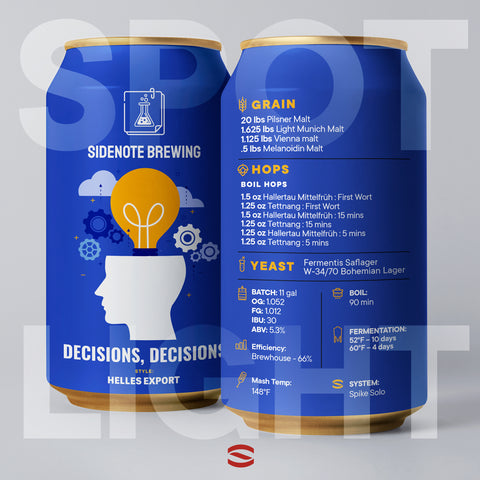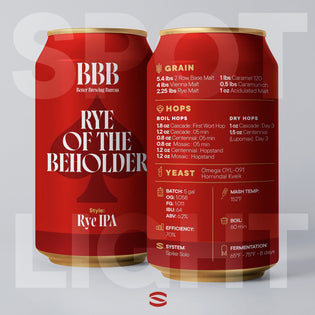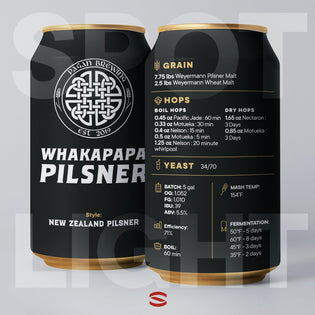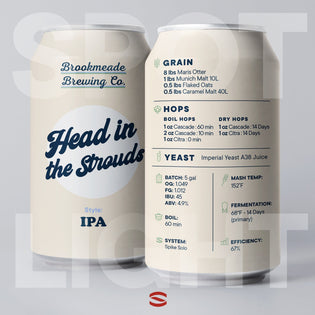 The Brewer: Scott Mendes
The Brewer: Scott Mendes
Hi, I’m Scott, proudly hailing from the city of New Bedford, Massachusetts. I’ve been brewing for six incredible years, and I’m the founder and creative mind behind Sidenote Brewing. My journey has led me to specialize in a diverse range of beer styles, including the hazy and hop-forward, sours, crispy and clean lagers, and rich robust stouts.

I craft my brews using a Spike Solo brewing system, outfitted with a Spike Steam Condensing Lid. Inside my brewhouse, you'll find two CF10 Unitanks, one CF15 Unitank, and two Spike Flex+ fermenters, which provide me with a versatile array of tools and options to foster experimentation, creativity and innovation.

While I dream of one day going pro and sharing my passion with a wider audience, I remain firmly grounded in the present, continually brewing and refining my skills. After all, it's the journey that makes the destination all the more rewarding.
So cheers to the craft, the dream, and to the unforgettable stories we share through the liquid we create!

The Beer: Helles
- A color spectrum ranging from medium yellow to deep gold. They are lighter than Munich Dunkel but slightly darker than a standard Helles lager.
- A moderate and well-balanced malt sweetness. Expect notes of fresh-baked bread, a grainy quality reminiscent of toasted grains or crackers, and subtle toasty sweetness in some variations, which all add depth to the malt profile.
- The flavor profile of German Export offers a harmonious balance between malt sweetness and hop bitterness. The bitterness is noticeable but not overpowering, creating a flavorful and highly drinkable lager.
- A clean and crisp fermentation character is highly desirable. Slow and cool fermentation, followed by lagering, allows the beer’s flavors to mature and harmonize, resulting in a high-quality, traditional German lager.
- The typical ABV range for a Helles Export beer falls between 5.0% and 6.2%. The ABV content contributes to the beer's drinkability and allows its malt and hop flavors to shine without being overpowering.
- To craft the most flavorful rendition of this beer, prioritize the use of premium malts. Specifically, employing high-quality Pilsner malt is paramount as it forms the bulk of the grain bill. The inclusion of Vienna and light Munich malts not only introduces complexity to the grain bill but also imparts delightful bready and grainy sweet malt undertones that harmonize beautifully with the floral and spicy nuances of Tettnang and Hallertau hops.
- After a lagering period of 3-4 weeks, indulge in the full flavor experience by serving it fresh in either a Willi Becher glass or a classic dimpled mug.

The Recipe: Decisions, Decisions

INGREDIENTS
GRAIN
- 20 lbs Pilsner Malt
- 1.625 lbs Light Munich Malt
- 1.125 lbs Vienna Malt
- 0.5 Melanoidin Malt
HOPS
- Boil hops: 1.5 oz Hallertau Mittelfruh - First Wort
- Boil hops: 1.25 oz Tettnang - First Wort
- Boil hops: 1.5 oz Hallertau Mittelfruh - 0:15 min
- Boil hops: 1.25 oz Tettnang - 0:15 min
- Boil hops: 1.25 oz Hallertau Mittelfruh - 0:05 min
- Boil hops: 1.25 oz Tettnang - 0:05 min
YEAST
- Fermentis Saflager W-34/70 Bohemian Lager

INSTRUCTIONS
BATCH SIZE: 11 gal
OG: 1.052
FG: 1.012
IBU: 30
ABV: 5.3%
EFFICIENCY: 66%
MASH TEMP: 148ºF
BOIL: 90 min
FERMENTATION:
52ºF - 10 days & 60ºF - 4 days
SYSTEM: Spike Solo

Pro Tips:
- Patience, Patience, Patience! Remember, patience is key when brewing lagers like Helles Export. It’ll be worth the wait.
- Make adjustments based on your specific equipment and conditions, and consider documenting your process for future refinement.
- Target a mash pH of 5.3-5.4 for optimal results.
- Consider using kettle finings like a Whirlfloc tablet or Irish moss to enhance beer clarity.
- When it comes to yeast nutrients, use approximately 1-2 teaspoons for an 11-gallon batch (or 0.5-1 teaspoon per 5 gallons).
- If opting for a decoction mash, remove melanoidin from the grain bill and replace it with Pilsner malt.
- Water Chemistry: Adjusting your water to a balanced sulfate to chloride ratio profile works well. My water profile for this beer was the following: Ca2+ - 53, Mg2+ - 6, Na+ - 14, CI - 80, S04 - 60, HCO3 - 16
- Ensure a controlled fermentation by pitching a sufficient quantity of healthy lager yeast at a cool temperature (around 50-55°F or 10-13°C).
- Perform a diacetyl rest by raising the temperature to 60-65°F (15-18°C) after primary fermentation to remove diacetyl.
- Speaking of diacetyl, use ALDC enzyme at yeast pitch if possible. ALDC, or alpha acetolactate decarboxylase, is “a helpful enzyme that can be added at yeast pitching or along with your dry hops to limit the production of Diacetyl to protect your finished beer from off-flavors and reduce the conditioning time needed before its ready to bottle or keg.”
- Cold conditioning at near-freezing temperatures (32-35°F or 0-2°C) for several weeks enhances flavor and clarity.
- Carbonate to moderate levels (around 2.5-2.6 volumes of CO2) for a balanced mouthfeel. This can be done during conditioning to save time.

Cheers,
Scott Mendes - Sidenote Brewing
Spike Summarizes: All Things Helles
What is a Helles beer?
Helles, pronounced as "hell-us," is a traditional German lager beer style known for its delicate balance of flavors, smoothness, and refreshment. Its name translates to "bright" or "pale" in German, referring to its clear and pale golden appearance. Helles is often regarded as a cousin to the more well-known Pilsner, but it has its unique characteristics that set it apart. In this comprehensive guide, we'll delve into the world of Helles beer, exploring its history, flavor profile, brewing process, food pairings, and more.
What distinguishes Helles from other beers?
Helles stands out for its emphasis on malt character, with a subdued hop bitterness. It's lighter in color and flavor compared to many other lagers, making it a supremely drinkable and sessionable beer style. While it shares some similarities with Pilsner, Helles tends to have a slightly sweeter malt profile and a softer hop presence.
What's the history of Helles beer?
Helles has its origins in Munich, Germany, where it was first brewed in the late 19th century as a response to the growing popularity of Pilsner-style lagers. Brewers aimed to create a beer that combined the drinkability of Pilsner with the traditional malt-forward character of German lagers. The style quickly gained popularity and remains beloved in Germany and beyond.
What does a Helles taste like?
Helles offers a well-balanced flavor profile that showcases its malt-forward nature. It features a gentle malt sweetness with notes of fresh bread, crackers, and a hint of honey-like sweetness. The hop bitterness is restrained, contributing a mild counterpoint without overpowering the malt. The result is a beer that's crisp, clean, and highly refreshing.
How is Helles beer brewed?
The brewing process for Helles involves mashing malted barley to extract sugars, boiling the wort with hops for bitterness and aroma, and then fermenting with lager yeast at cooler temperatures. The choice of malt and hops is essential, as they influence the beer's color, flavor, and aroma.
What are the essential ingredients in Helles?
The key ingredients in Helles include malted barley, hops, yeast, and water. Pilsner malt is commonly used, contributing a pale color and a clean maltiness. Noble hops, such as Hallertau or Saaz, are often chosen for their mild bitterness and delicate aroma.
What foods go best with Helles?
Helles' balanced and subtle flavors make it a versatile pairing option. It complements a range of dishes, including grilled sausages, roasted chicken, seafood, salads, and even spicy foods. The beer's malt sweetness and gentle bitterness can help cut through rich or spicy flavors, creating a harmonious match.
How strong is a typical Helles?
Helles beers typically have an alcohol content ranging from 4.5% to 5.5% alcohol by volume (ABV). This moderate strength contributes to their sessionable nature, allowing you to enjoy a few without feeling overwhelmed.
Are there different types of Helles beers?
While Helles itself is a distinct style, variations can exist based on regional preferences and brewery interpretations. Some variations might include a slightly stronger version known as "Export Helles" or a "Munich Helles" that adheres to specific brewing traditions in the city of Munich.
What are some popular brands of Helles?
Several German breweries are renowned for their Helles beers, including Weihenstephaner Original, Ayinger Helles, and Augustiner Helles. These brands offer exemplary examples of the style, showcasing the craftsmanship and tradition behind Helles.
Why does Doppelbock have a pale color?
The pale color of Helles comes from the use of pale malts, such as Pilsner malt. These malts are kilned at lower temperatures, preserving their light color while still providing the necessary fermentable sugars for the brewing process.
Is Helles a good beer to brew for beginners?
Yes, Helles is an excellent choice for beginners. Its balanced flavor profile, moderate bitterness, and clean finish make it highly approachable, even for those who are new to the world of craft beer.
How does Helles compare to lagers?
Helles beer is often compared to other lagers like Pilsner and Märzen. While all these styles fall under the lager category, they have distinct characteristics. Helles is malt-forward with a slightly sweet taste, whereas Pilsner is crisper with a more pronounced hop bitterness. Märzen, on the other hand, tends to be maltier and has a touch of caramel sweetness.
Why is Helles often served in a specific type of glass?
Helles is typically served in a traditional German beer mug or a stein. These glassware options allow you to appreciate its color, maintain its carbonation, and capture its subtle aroma. The broad base of these glasses also provides a comfortable grip, enhancing the overall drinking experience.
What's the difference between Helles and Kölsch?
Helles and Kölsch are both German beer styles, but they have distinct origins and characteristics. Helles is a Bavarian lager known for its malt-forward profile and pale color. Kölsch, on the other hand, originates from Cologne (Köln) and is an ale that's often described as having a more balanced flavor with a slight fruitiness. Kölsch is also usually lighter in color compared to Helles.
Is Helles a seasonal beer?
Helles is not strictly a seasonal beer; it's enjoyed year-round. However, its crisp and refreshing qualities make it particularly popular during the warmer months when people are seeking lighter and more thirst-quenching options.
How does the brewing process affect Helles' flavor?
The brewing process plays a crucial role in shaping Helles' flavor. The choice of malt and hops, as well as the fermentation temperature, impacts the beer's taste. Using Pilsner malt results in a pale color and a clean, bready maltiness. Noble hops contribute mild bitterness and delicate aroma, while lager yeast fermentation imparts a smooth and crisp finish.
Are there any modern twists on the traditional Helles style?
Some modern craft breweries experiment with Helles by adding a creative twist, such as dry hopping with aromatic hops to enhance the beer's aroma or incorporating unique ingredients for added complexity. These variations still maintain the core characteristics of Helles while offering a new dimension of flavor.
Is Helles gluten-free?
No, Helles is not gluten-free, as it is made from barley malt. However, there are gluten-free beer alternatives available on the market for those with gluten sensitivities.
Where can I find Helles beer festivals?
In Germany, you can find Helles served at many traditional beer festivals, including Oktoberfest in Munich. Additionally, craft beer festivals around the world often feature a wide range of lager styles, including Helles.
Is Helles suitable for aging?
Helles is best enjoyed fresh to savor its delicate malt and hop balance. Unlike some stronger ales, which benefit from aging, the subtleties of Helles can diminish over time.
What's the best way to pour Helles beer?
To pour a Helles beer, hold the glass at a slight angle and pour the beer down the side. As the glass fills, gradually straighten it. This method helps preserve the beer's carbonation and head, ensuring you get the most out of its aroma and visual appeal.
Is Helles beer known by any other names?
In Bavaria, Helles may simply be referred to as "Helles Bier" or "Hell." While the term "Helles" is widely recognized among beer enthusiasts, regional names might vary based on local dialects.
How can I learn more about Helles beer?
To dive deeper into the world of Helles beer, you can explore books on beer styles, brewing techniques, and history. Additionally, attending beer tastings, visiting breweries, and engaging with beer communities online can provide valuable insights and knowledge about this classic style.





